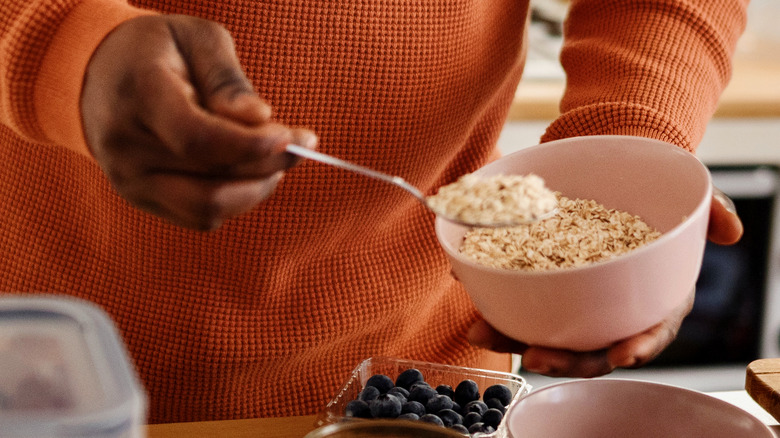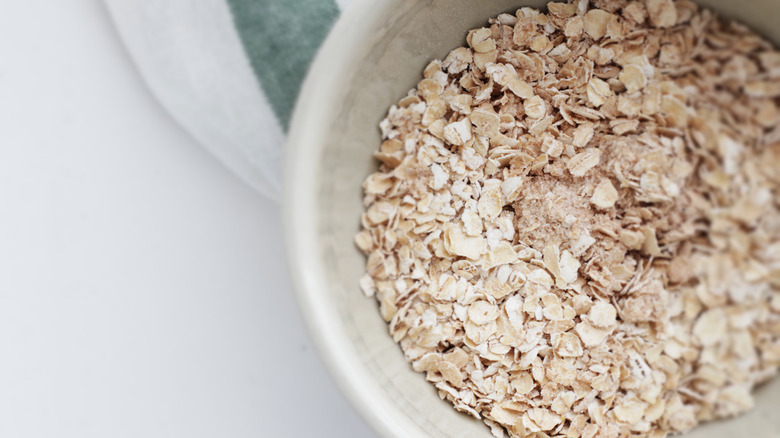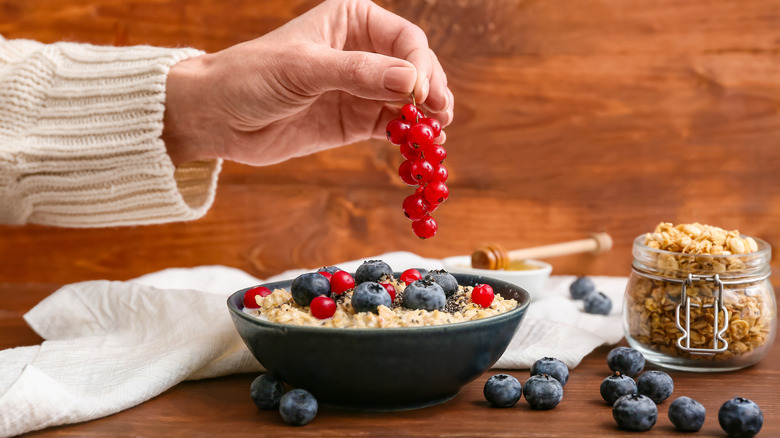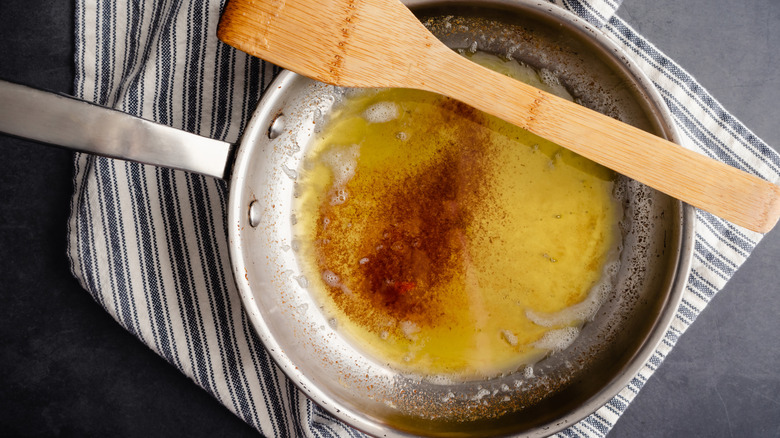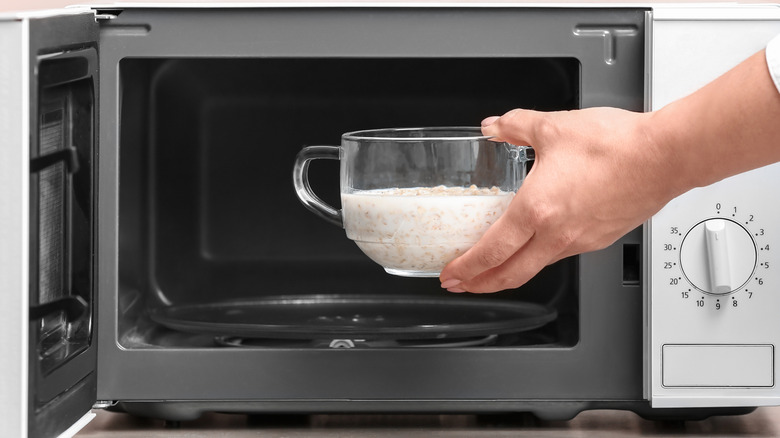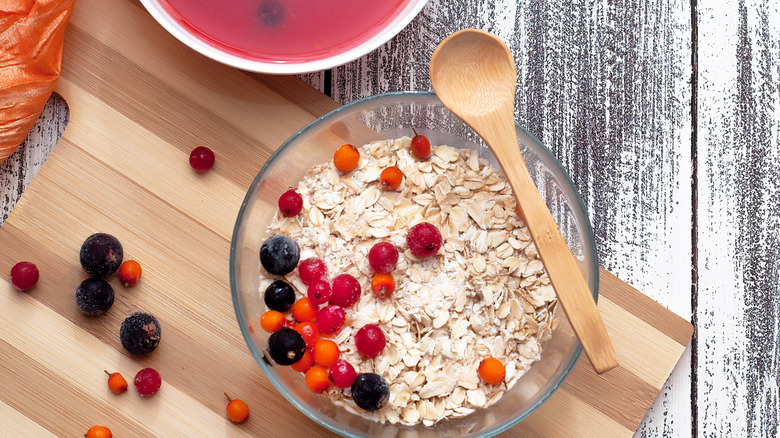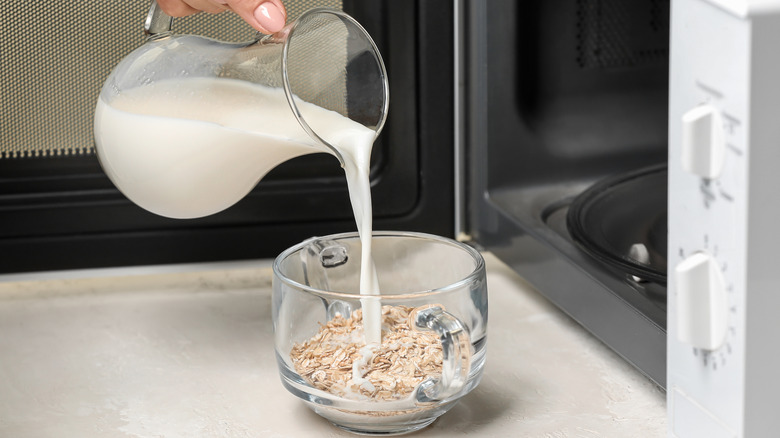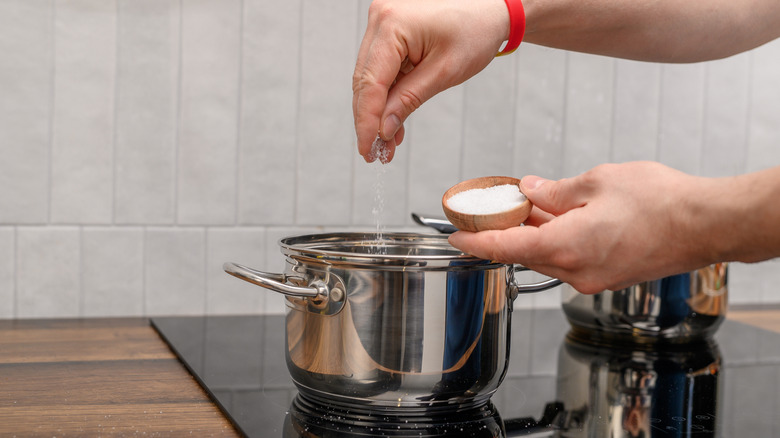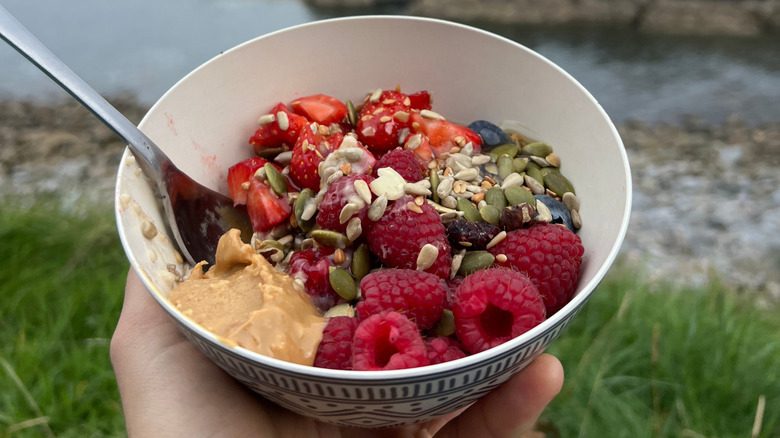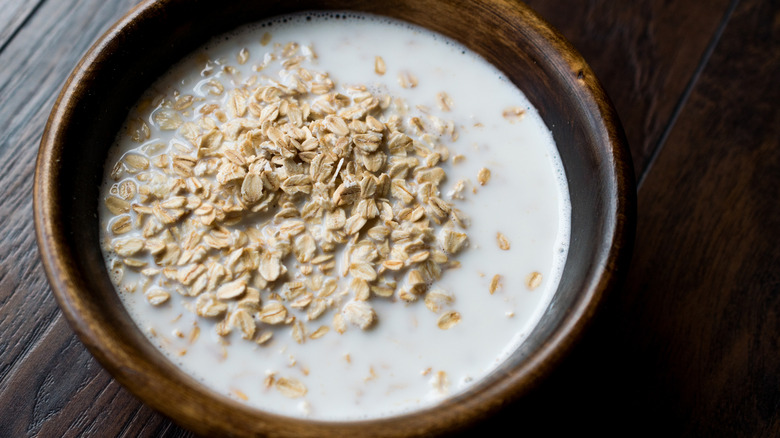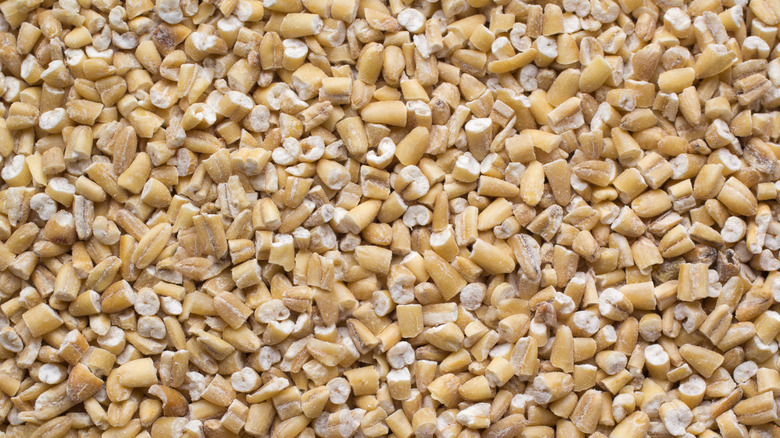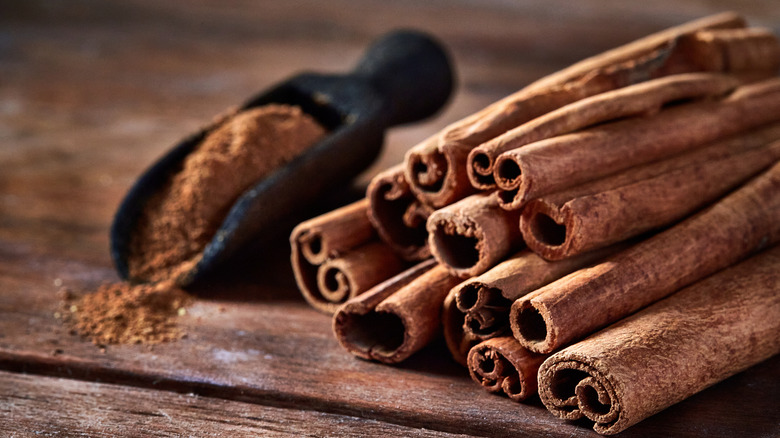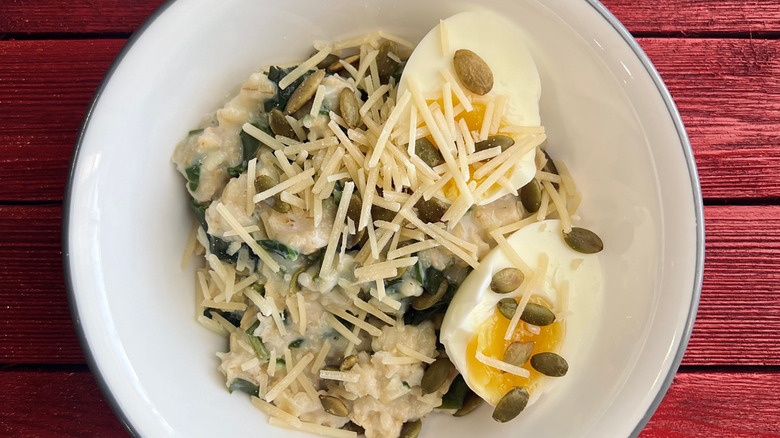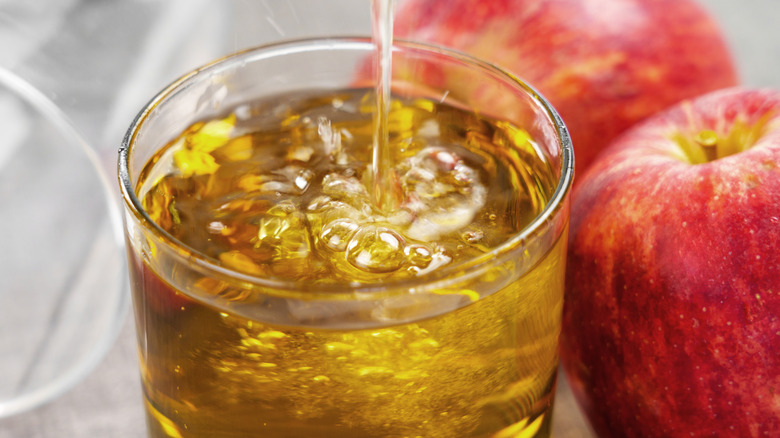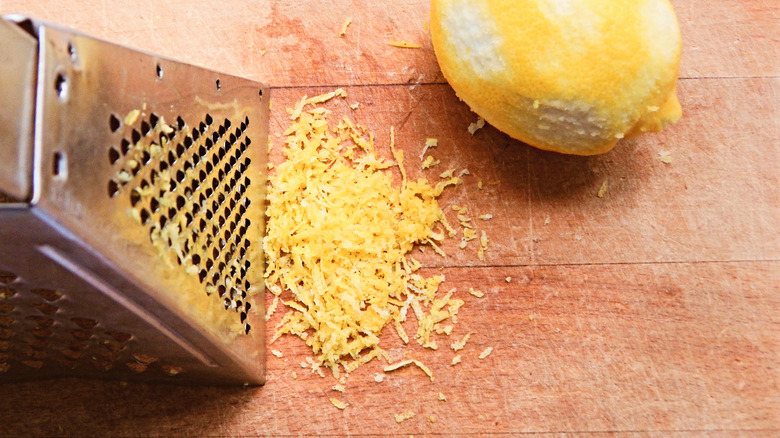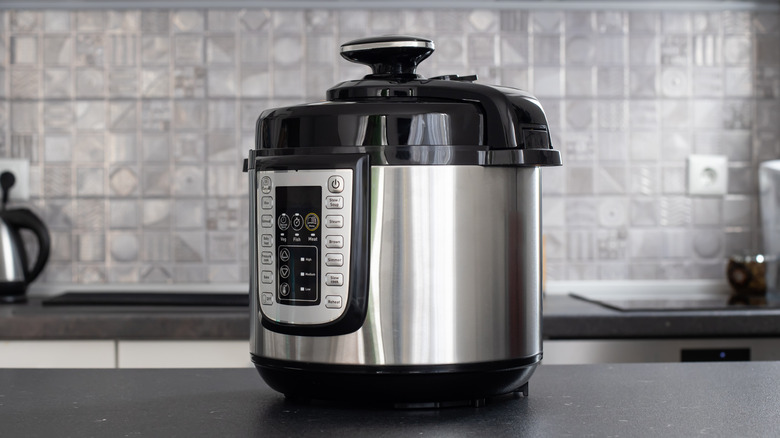The Biggest Mistakes People Make When Cooking Oatmeal
Oatmeal is one of the most mundane, easy-to-prepare breakfast picks on the face of the Earth — or so it would seem. Though cooking oatmeal isn't a task you'd think would require chef-worthy techniques, we've all undoubtedly encountered a bland, gloopy, or otherwise ill-tasting bowl of oatmeal at least once, meaning how you approach your oats just might make or break breakfast. Thankfully, we've got a few tips we think will help you produce consistently delicious-tasting oatmeal, every time.
In this post, we're unraveling the common mistakes people make when cooking oatmeal while providing easy and simple ways to overcome them. From discerning between oat types to tossing in surprising and alluring ingredients, we've got the info you need to take your next bowl of oatmeal to the next level. Just remember that oatmeal can be a matter of preference and that some of these tips may or may not align with what you consider a great bowl of oats. With that said, grab a spoon and join us as we reveal the biggest mistakes people make when cooking oatmeal — and how to fix them.
Thinking instant-oats and quick-cooking oats are the same
A common mistake people make with oatmeal is assuming that "quick-cooking" oats and "instant" oats are the same. In reality, though both types of oats are designed to take less time to cook than old-fashioned or steel-cut oats, instant oats are the variety that cook fastest.
Instant oats can be prepped in as little as one to three minutes while quick-cooking oats can be prepared in about one to five minutes. The differences between them lie in the mill and texture. Instant oats are rolled flatter than quick-cooking oats, and some instant oats even come pre-cooked. What's more, instant oats are also often milled finer than quick-cooking oats, boosting their fast cook time even more. Though the differences between instant oatmeal and quick-cooking oats aren't very significant, they are still worth understanding, especially when determining which oats are the best pick for you.
Undercooking or overcooking your oats
Whipping up a bowl of oatmeal is a nuanced task, and when it comes to cook times, you'll want to pay extra close attention. Simmering your oats too long can affect the consistency, making your dish gloppy and almost glue-like, especially when cooking instant oatmeal. Undercooking oats has the opposite effect, often leaving your them swimming in liquid while sporting an unpleasantly crunchy texture.
So, where's the happy medium? As simple as it might seem, we recommend cooking your oats for the amount of time recommended on the packaging and adjusting from there. If you like your oats with a little extra texture, cut the heat a minute or two ahead of the suggested cook time. Like your oats on the richer and creamier side? Cook them only a minute or so longer, increasing the amount of liquid as you go (if needed) to prevent them from drying out.
Adding fruit too early
Adding fruit to oatmeal is a great way to achieve sweetness without needing to use excessive amounts of sugar, but should you always add your fruit to your oatmeal at the beginning of the cooking process? We vote no. Actually, there are some fruits, like strawberries, that may turn to mush if you do, with the same being true of other berry types, including blueberries.
Instead of adding fruit to oatmeal at the beginning of the cooking process, try adding them only at the end. Doing this will help the fruit retain its shape and full-bodied flavor. If you're using frozen fruit and want it warmed through, chuck the fruit in a few minutes before your oats finish cooking. This will give them time to infuse your oatmeal with flavor without turning them into gunk or altering their flavor. Please note that this tip might be a matter of personal preference, so if you'd rather enjoy softer fruit in your oatmeal, by all means, do what suits your tastes best!
Not toasting oats before making them
Did you know you can toast oats in a way similar to toasting rice? It's true. Toasting your oats before making them can add a cozy and unexpected layer of flavor to your morning bowl, and though it sounds complicated, we're here to tell you that it isn't. To toast your oats, simply melt a pat of butter in your pan and toss your oats in. Cook your oats in the butter for a couple of minutes to infuse each grain with toasty flavor. From there, proceed with your recipe as desired, adding liquid and any additional ingredients you choose.
If you plan to add other ingredients that might benefit from toasting, feel free to add them to the mix, too — coconut shreds, crushed pecans, cinnamon, spices, and other yummy additions are great candidates. Don't forget a splash of maple if you want to impart extra sweetness.
If you aren't into using butter or don't have any on hand, you could easily toast your oats in a little oil, but don't overdo it. Be sure to select oil with a neutral or complementary flavor — light olive oil or coconut oil are great options.
Not using a big enough bowl when microwaving oats
Not that it's ever happened to us or anything, but a volcanic eruption of oatmeal in the microwave is a great way to ruin the feel-good morning mood. If you know, you know. Even so, there's a simple enough way to remedy the situation, and that's to simply place your oatmeal in a bigger (microwave-safe) bowl.
Now, we'll be the first to say that whether your oatmeal overflows in the microwave isn't restricted only to bowl size, but using a bowl that's a bit larger than one you'd normally use can help. You may also want to consider using a bowl with higher sides. Additionally, try stopping the timer and stirring at every 30 to 60 second interval — this can ensure that your oatmeal cooks happily without the impending doom of that hot and bubbling hard-to-clean mess that often ensues from an unmonitored bowl of oats.
Overcomplicating the ingredients
This one's an innocent mistake, but it may cost you, especially if you have an appreciation for the natural taste of pure oats. While it's fine to flavor your oatmeal, loading it down with excessive amounts of sugar, extracts, and other toppings isn't usually necessary. Instead, consider adding ingredients to complement the natural taste of your oatmeal rather than mask it. A great way to do this is to start small. A drizzle of maple syrup over a few slices of banana and a light dusting of cinnamon might be all your taste buds need.
Not quite satisfied with that? Amp things up by throwing in a few delectable pecans (this might be a great time to learn the trick to shelling pecans by hand) along with a teaspoon or two of any variety of jam, jelly, marmalade, preserves, or compote. As you lightly layer your oatmeal with tasty flavors, you might just surprise yourself. Have fun and switch it up from time to time to see which beautifully simple oatmeal topping combinations you love most.
Adding too much (or not enough) liquid
Adding more liquid to your oatmeal is a great way to achieve a creamier texture; however, adding too much of it can spell trouble as doing so can often make it gloopy or watery. If you've added a little too much liquid to your oatmeal, it's possible to remedy the issue by cooking your oats a little longer than normal. Yes, doing so may affect the texture, but it might prove a better option than eating soupy oats. Also, if it is early enough in the cooking process, you could consider simply adding more oatmeal to the mix. Just be sure not to do this too late in the game, as you'll could end up with both soft and hard oats in your bowl. Keep in mind that oatmeal often thickens as it stands, so what you see in the pot isn't always representative of what you'll get once it has cooled.
Skimping on liquid is another no-no, since doing so may yield oats that are dry, crackled, and not the least bit appetizing. If you've made this mistake, you can fix the issue by adding a splash or two of milk or water and stirring until well incorporated. Continue to add liquid until it reaches the desired consistency.
Forgetting a dash of salt
Adding a dash of salt to your oatmeal isn't intuitive, but it makes a difference, especially if you plan to add sweetener. As you may already know, adding a bit of salt to food items containing sugar can enhance its sweetness, making it that much more palatable to the tongue. Ever heard of salted caramel? The same concept applies here. Simply add a pinch of salt (guidelines for exactly how much salt to add are usually printed on your oatmeal label, as how much you'll add may vary between brands and oatmeal types) alongside your choice of sweetener for more flavor packed in every bite.
With that said, you'll want to be careful not to over-salt your oatmeal. Always measure the amount of salt you're putting in to prevent adding too much. Additionally, we'd recommend forgoing the addition of salt if you plan to eat your oatmeal plain — unless you prefer salty-savory oats, that is.
Not adding fat
Adding fat to oatmeal is yet another counterintuitive tip we have for you, and doing so has several benefits. The first is that adding fat to your oatmeal can curb insulin spikes caused by the carbohydrates contained therein. In addition to stabilizing your blood sugar, combining a form of fat with oats can also keep you feeling full for longer.
So, what kind of fats should you be adding to your oatmeal? No, we aren't talkin' bacon grease, here. Instead, add a dollop of nut butter or a splash of heavy cream to the mix for a surprisingly satisfying flavor. For a comforting twist, try adding a pat of butter to your oats (even if you don't plan to toast them) along with fried apples, cinnamon, and a couple of teaspoons of pure maple syrup, which is (usually) easily found at your local grocery store. Sure, it's not quite apple pie, but your taste buds might be hard-pressed to tell the difference.
Other fatty ingredients to try in your oatmeal include the addition of nuts like almonds, peanuts, pecans, walnuts, and more. Go nuts (literally), and your stomach will thank you — even hours later.
Being afraid of plain oatmeal varieties
We know, we know. Plain oatmeal sounds so boring when compared to the many fruit-flavored packets available on store shelves. And while we agree that many store-bought oatmeal brands are quite good, we also know that tons of them are packed with sugar, especially if you're accustomed to eating several packets of oatmeal in one sitting.
Instead of downing sugar-laden fruit-flavored packets of instant oats, why not buy plain oatmeal and come up with unique combinations at home? There are plenty of tantalizing oatmeal combinations out there that will not only taste amazing but will also prove beneficial for your health. Try this big batch Swoalts mush recipe or healthy coffee oatmeal (yup, it's a thing) to start. You could even come up with your own oatmeal combination by adding your choice of sweetener, fruit, and nuts. Not into fruit? Be sure to stay tuned; we've got the scoop on how to take your bowl of oats from sweet to savory with just a few swaps coming up.
Not knowing the difference between steel-cut and old-fashioned oats
A common mistake that people make when selecting which oats to use is failing to realize that steel-cut oats are completely different from old-fashioned rolled oats. Though the former tends to be healthier for a number of reasons, including being the less processed option of the two, old-fashioned oats are more common, absorb water easier, and have a consistent texture.
Steel-cut oats, in essence, are oats that have had their outer kernel removed before the remaining grain is coarsely chopped. They sport a different texture compared to traditional rolled oats, tend to be chewier, and pack more flavor. Old-fashioned "rolled" oats have also had their tough outer shells removed but are steamed and rolled flat, hence the name. Because of the steaming process and their flatter shape, they take less time to cook compared to steel-cut oats and are also milder in flavor.
Which you choose to eat is up to you; however, making the distinction between these two oat types is imperative. Mistaking one for another might give you quite a shock come breakfast time.
Neglecting to add spices
Aside from adding fruit, a sweetener, and fat to your oatmeal, there is yet another way to add dynamic flavor, and that's by layering in your choice of warming spices. Though cinnamon is a commonly used ingredient in oatmeal, it certainly isn't the only spice worthy of your consideration. Cloves, ginger, and nutmeg are other delectable additions, as is cardamom and coriander. Just be sure to add a little at a time, especially if it's a spice known for its potent flavor, especially if you've never sampled it in oatmeal before.
Considering its delicate taste and texture, adding too much of any of the aforementioned flavors could ruin your oats. Combine with other options previously discussed (we love the taste of oats toasted in butter cooked with milk, walnuts, raisins, pure maple syrup, and a dash or two of cinnamon, clove, and nutmeg) for a truly scrumptious way to start the day.
Forgetting that oatmeal can be savory
Most people think of sweet toppings when it comes to oatmeal, but as promised, we've got a few savory additions we think could upgrade your morning indulgences, as well. We scoured the internet for fun ideas people came up with for jazzing up their oatmeal umami-style and were surprised with what we found. Soy sauce, sesame oil, green onions, and mushroom oatmeal topped with a fried egg was one of many savory suggestions, as was oatmeal cooked in chicken broth, milk, and water, seasoned with garlic and onion, and topped with cheddar. Try other upgrades, like adding sliced avocado and trendy chili crisps to your oatmeal base for unexpected flavor.
We love the idea of adding savory additions to oatmeal as many of them, including avocados, cheese, and eggs, contain healthy fats that can keep you satiated throughout the day. Moreover, these umami and sometimes spicy flavors work to keep oats interesting, making them an even more versatile ingredient that you could enjoy for breakfast, lunch, and dinner.
Not experimenting with your liquid base
Another common mistake we often see people making is not experimenting with the liquid base of their oatmeal. Yes, we know that the directions on the package say to use water, but there are so many other types of liquid you could use to make your oats taste that much better.
We already touched on the idea of using soy sauce and broth for umami oatmeal flavors, but there are plenty of sweet switch-ups, as well. We love using apple juice in place of water, as this adds a natural sweetness to the oatmeal, lessening the need for throwing in copious amounts of sugar. Other options are to include a splash or two of different flavored fruit juices or to experiment with different ratios of cream, milk, or water.
Be sure to use caution when adding certain ingredients as adding too much may ruin your bowl of oats. Using too much heavy cream may cause your oats to become too heavy, rich, and dense, and using certain juices, like orange juice, may cause separation and curdling when combined with dairy products like milk.
Forgetting to try zest
If you haven't considered adding zest to your oats in the morning, you don't know what you're missing. The combination of citrus zest to your pot of oatmeal in tandem with complementary fruits and nuts is one of the best-kept secrets for upgrading a hearty bowl of oats.
One great way to test out this flavorful trick is to combine water and milk in a pot of oatmeal along with the zest of an orange and a handful of blueberries. Add your choice of sweetener, stir, and cook to your desired consistency. You could also switch things up by substituting the blueberries with the fruit of your choice, then using the zest of a lemon, orange, or even lime (if you're up for it) to come up with your own unique oatmeal flavoring. A small amount of fine zest is all you need to make the flavor of your oatmeal come alive with plenty of refreshing citrus flavor.
Not using an Instant Pot
Did you know you can use your Instant Pot to make oatmeal? You can! And while Instant Pot oatmeal might not be the shortcut you think it is (you still need to allow time for your Instant Pot to come to pressure and release steam), it's still a convenient way to make oatmeal without needing to babysit it over the stove or in the microwave.
To make Instant Pot oatmeal, you'll combine old-fashioned rolled oats in your Instant Pot along with water at a 1-to-2 ratio. For 2 cups of rolled oats, you'll need to cook the oatmeal for about four minutes. Once cooked, allow your Instant Pot to release its steam. Once the steam has been released, carefully open the lid and stir. You'll be left with deliciously creamy oatmeal that you can top with any of your favorite ingredients, including a drizzle of honey, a sprinkling of cinnamon, or summer fresh berries.
